|
|
Greetings to all readers,
Well, the “Nationals,” or the “Zenkoku,” i.e. the Zenkoku Shinshu  Kampyokai, or National New Sake Appraisal, is finished for another year. Whew. What an ordeal. 1000 sake – and I try to get through them all in five hours. Impossible for most, me included, but damn if I don’t try every year. Frankly, it sucks, if you’ll excuse my lack of eloquence. Kampyokai, or National New Sake Appraisal, is finished for another year. Whew. What an ordeal. 1000 sake – and I try to get through them all in five hours. Impossible for most, me included, but damn if I don’t try every year. Frankly, it sucks, if you’ll excuse my lack of eloquence.
However, undoubtedly, I learn a massive amount about sake and this year’s brews. So yes, the discomfort is worth it.
Enjoy the newsletter,
John
|
Sake Brewing Songs

Over the many centuries across which sake brewing developed, 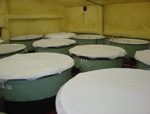 necessity was again and again the mother of invention, and creativity at every juncture was indispensible. Naturally, this refers to technical and industrial developments of course, but to many “intangible cultural assets” as well. And, sadly, many if not most of those are fading into oblivion, never having been recognized for their value by the masses. necessity was again and again the mother of invention, and creativity at every juncture was indispensible. Naturally, this refers to technical and industrial developments of course, but to many “intangible cultural assets” as well. And, sadly, many if not most of those are fading into oblivion, never having been recognized for their value by the masses.
One of those intangibles is music. Specifically, sake-tzukuri uta, or  “sake-brewing songs.” As you have likely gathered, these are songs that were sung during the sake brewing process. But they were much more significant, and served much more of a purpose, than your typical hearty round of “Ninety-nine bottles of beer on the wall.” “sake-brewing songs.” As you have likely gathered, these are songs that were sung during the sake brewing process. But they were much more significant, and served much more of a purpose, than your typical hearty round of “Ninety-nine bottles of beer on the wall.”
Who was it that wrote and sang these songs? Just about every brewer in the country, back then, from the toji on down. Certainly it was a more established practice in some kura and regions than others (and just as certainly, one secret to the success for some), but more or less brewers across Japan were from long ago singing songs as they worked.
The songs themselves differed, of course, and greatly. Each region had their songs, and usually this was tied in with the toji guild (master brewer guild). But then, the toji guilds themselves were all very regional back then. And there was a song for every job… by some accounts, they were singing constantly.
Why’d they sing? A myriad of reasons, to be sure. But surely the 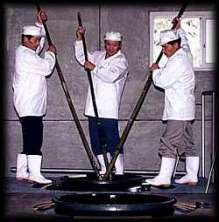 biggest was to make better sake. Remember that long ago there were no watches or clocks. biggest was to make better sake. Remember that long ago there were no watches or clocks.
So, in modern times, a toji can say, “do this until about 4:30, then report back to me.” Long ago this was not possible. Sure, he could have said, “Do this until exactly midway between the Hour of the Ox and the Hour of the Tiger,” but you’d be at the mercy of the local temple bell. Or he could say, “do this one million times, then call me.” But the pitfalls of that are obvious too. At whose pace? And if I forget where I am, do I start over, or what?
So what they did say was, “OK, mix this moto (yeast starter) for ten rounds of ‘the moto song,’ then go clean the baskets over there.” Or “Let’s all mix this moromi (fermenting mash) for six full recitations of ‘the moromi mixing song’ before we break for lunch.”
And what it did provide was that all-important factor in sake brewing, consistency. Every step of every batch would get the same treatment as its peers, so brewers had one less unknown to deal with when brewing. So time and counting were two reasons; another was rhythm. If you have a bunch of guys ramming long poles into a thick mash, they better be in sync or you’re going to have a big ole’ mess on your hands, if not injuries. The “All together now!” spirit helped maintain that order.
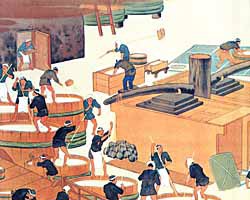
And, yet another reason was to make monotonous work, at least marginally, stimulating thereby staving off fatigue. Minding your sharps and flats helps you keep in tune with your surroundings, and helps avoid getting tired from repetitive rote activities.
A website on the sake-brewing songs of the Nada region suggested that, indeed, brewers were constantly singing. And; apparently, that alone qualified one to work in a kura back in the day. “Singing well is practically the only requirement for getting hired here,” went one old toji joke.
There were songs for washing the tanks, mixing the moto (yeast starter), adjusting the temperature of the moto by swishing within it jars of hot water or ice, drawing water, adding water to the tanks, and adding water to the moto when it was ready for it. (And all of them have much cooler sounding names in Japanese than the above descriptions.) There was even a song called “the after-the-evening-bath” song for the job they had to do each night after their bath. Each of course had its own tempo and content.
Apparently, the lyrics were nothing to get excited about, and were rather meaningless and mundane. But that did not stop some from preserving, eventually recording, and even making CDs of them.
The above mentioned website can be found here.
If both you and your computer can read Japanese, you can learn a bit more about these songs and their content. If not, no worries, go to the bottom of the page and you will find two links that will let you hear the tank-washing song and the adding-water song.
There is this link on the site for Michizakari sake (from Gifu Prefecture). As you’ll hear from the audio link on this page, not only was there a song for every job but; apparently, there was one to be sung when a bodypart gets stuck in a brewing operation gone awry. Or at least so it sounds to me. But I digress.
Research on the internet revealed quite a bit. While I own one CD of Nada Sake-tsukuri songs (picked up at Hakutsuru’s museum in Nada, but you can order yours here), I found another one of those from Echigo (modern day Niigata). Ozeki, another large brewer in Nada, has a lot of information on their site too, including clickable audio links. Surely there are more for those with the requisite interest.
While these intangibles may not help you enjoy your sake more, knowing more about the culture that makes sake what it is can only be a good thing, and help sing the praises of sake e’er more.
|
Did You Know?

Most sake breweries traditionally brew in the winter, from about October to about April. There are breweries of all sizes and scales. Traditionally, most breweries would brew according to one of two patterns: starting a batch every day, or starting a batch every other day.
Which of these two were employed depended upon a myriad of things: the number of tanks they have (the month-long fermentation of a given tank must finish before they can fill it again with the next round!), how big those tanks are, how many kurabito (brewer workers) there are, and more. A kura making 50 tanks might start one every other day, finishing in two months – not including the month of preparation and a few weeks of cleanup. Another kura making 100 might need four months if they used the same pattern, but half the time if they start one every day.
Personally, this is one of the most interesting aspects of visiting a sakagura – how many people, how many tanks, how much does each yield, and how often do they start a batch. These dynamics have a whole lot to do with the nature and quality of a kura’s sake.
|
Sake Basics

Kikichoko: What and Why
Kikichoko are official sake tasting cups. They have been in use for well over a century, and are seen in sakagura everywhere. White porcelain with bright blue concentric circles emblazoned on the bottom, these cups hold just about 180cc (almost six ounces). 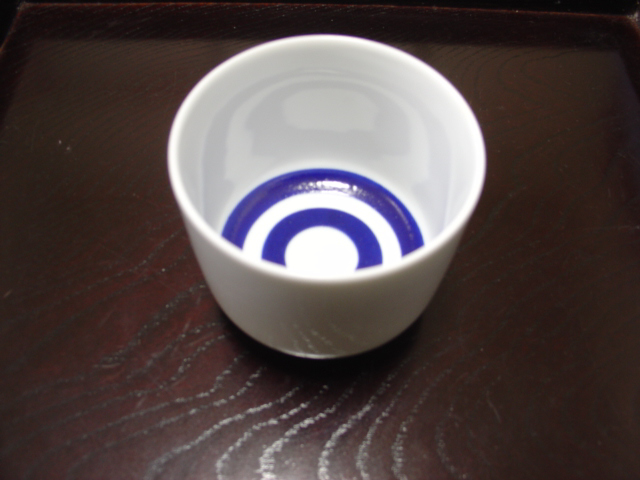
The cups are large enough to allow a taster to explore the aromatics. The white background allows the taster to assess color. What about the blue circles at the bottom?
Long ago, much more sake was much more susceptible to going bad, getting cloudy and generally nasty during storage. Tasters can look at where the blue and white meet, and see the clarity and luster of a sake very easily. Any cloudiness or diffusion of that edge would indicate an improperly stored sake. more sake was much more susceptible to going bad, getting cloudy and generally nasty during storage. Tasters can look at where the blue and white meet, and see the clarity and luster of a sake very easily. Any cloudiness or diffusion of that edge would indicate an improperly stored sake.
While this is not the problem it was a century ago, the glasses are still commonly used. They may not be the best for all types of sake, but they do present an even playing field for assessing a group of sake at one time.
|
Events

Ginjo Bar open daily in Shimbashi
The Nihon Ginjo-shu Kyokai, that veritable group of 56 ginjo breweries around the country, will be using the space of Shimbashi Kuri from June to the end of August. From 2:00 pm until 9:00 pm you can taste the sake of these 56 sterling breweries from all over Japan. A small glass (45ml) will set you back just \200 to \400, presenting the chance to try a wide range of sake for a reasonable outlay. A list of which brewers will be there pouring their brews and when can be found here:
“Josei Kurabito no Bishu wo Ajiwau Yube”
“Delicious Sake Brewed by Women” Tasting
On Sunday, June 20, from 5:00pm to 7:00pm, a group of 26 kura from around the country where women do at least some of the brewing will hold the Zenkoku Josei Kurabito no Bishu wo Ajiwau-yube, or “An evening with delicious sake brewed by women from all over the country.” (Another situation where the original Japanese sounds much cooler…)
To be held at the Riga Royal Hotel in Tokyo, this event also promises to be a great tasting with a great theme. Although neither comprehensive nor complete in terms of sake brewed by women from all over, the range of styles and potential enjoyment factor are towering.
Reservations are mandatory and being handled by the hotel. If you are local and free, please call 03-5285-8962 to attend.
Nihonshu Festival
On Sunday, July 11, the proprietors of the restaurant Shuen Kawashima will hold the tenth annual Nihonshu Festival, a tasting party replete with great food and a lively atmosphere. If you are anywhere near Tokyo, I highly recommend this bash.
What’s so special about it? Why, the sake that is there, that’s what. Sure, there are plenty of decently well known brands and established high quality producers. But on top of that, perhaps two-thirds of the sake there is from little known, smaller producers that might not get into mainstream distribution. Mostly hit, a little miss, a ton of fun. And the food is made by three or so restaurants that focus on sake, so you know it’s gotta rock.
The event has two sessions, 12:00 to 3:30 and 4:30 to 8:00. Pricing is complicated: \7000 for one session, \10,000 for both, \12,000 for couples attending one session. Day of show all prices go up \2000 per person.
Trust me: this one is fun, educational, and worthwhile. Be there if you are even close.
THE NIHONSHU FAIR
The Nihonshu Fair, the Tokyo version of the national new sake tasting
combined with the JSBA’s huge-ass tasting with booths from every
prefecture and more, will be held in Ikebukuro in Tokyo at Sunshine
City. Designed for consumers, last year, 3700 people showed up. If you are anywhere remotely near Tokyo, I highly suggest you check it out. More is available in Japanese here. If you want to attend, but need help, feel free to contact me directly.
~LAST NOTICE~
The Sake Professional Course
There are currently three seats open for the below event. Please contact me asap if interested.
San Francisco, CA, June 20, 21 and 22, 2010
On June 20, 21 and 22, 2010, I will hold the fifth stateside version of the Sake Professional Course at the Bentley Reserve in San Francisco. The content of this three-day intensive sake course will be identical to that of the Sake Professional Course
held each January in Japan excepting, of course, sake brewery tours. The course is geared toward industry professionals wishing to expand their horizons in a thorough manner into the world of sake, and will; therefore necessarily, be fairly technical in
nature and; admittedly, somewhat intense. But the course is open to anyone with an interest in sake, and it will certainly be fun!
The course lectures and tastings will begin with the utter basics and will thoroughly progress through, and cover everything related to, sake. There will be an emphasis on empirical experience with plenty of exposure to a wide range of sake in the tasting sessions throughout the three days.
The goal of this course is that "no sake stone remains left unturned." Every conceivable sake-related topic will be covered and each lecture will be complemented and augmented by a relevant tasting. Like its counterpart held in Japan each winter, it will be, quite simply, the most thorough English-language sake education in existence. Participants will also be presented with a certificate of completion at the end of the course and will also have the opportunity to take an exam for Level I Sake Specialist certification immediately following the course. The cost for the three-day class, including all materials and all sake for tasting, is US$775. There are, at present, but five seats left. For a view of the syllabus, please visit sake-world. Testimonials from past participants are there too. For reservations or inquiries, please email me here.
Check out testimonials written by past participants here.
|
Japanese For Sake Lovers
A Guide to Proper Pronunciation
Here it is: something that ensures you will enjoy your sake experience more and more - a short, concise instructional guide on how to properly and naturally pronounce the Japanese language, sake brand names, and all the terminology that is a part of the sake world. With the help of this little course, you will sound like a native when talking about sake.
No more butchering sake names in Japanese! Learn how to properly pronounce the sake you love!
Japanese for Sake Lovers consists of a short text and three audio files. It all begins with a guide to the theory of pronouncing Japanese, which you will soon realize is surprisingly simple. Following that, you will have the opportunity to practice pronunciation of all the important terminology surrounding sake, and dozens of brand names that cement in your mind the principles, fundamentals, and idiosyncrasies of pronouncing Japanese.
This is not a language text. You will not learn grammar or much 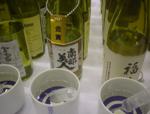 vocabulary outside of sake-specific terms; although, it does include a handful of phrases to help you navigate your way to sake bliss in Japanese when at a sake pub. It is augmented by three audio files that allow you to practice, repeating the words and phrases after a native speaker. vocabulary outside of sake-specific terms; although, it does include a handful of phrases to help you navigate your way to sake bliss in Japanese when at a sake pub. It is augmented by three audio files that allow you to practice, repeating the words and phrases after a native speaker.
Go here now to order your copy for $14.99, and feel one step closer to the beverage you love – guaranteed.
|

Are you not getting this newsletter? I realize that is like asking that "those not present please raise your hand," but for future reference, should you spontaneously stop receiving this newsletter, please go here and sign up again. Should that not work, please go to www.sake-world.com.
Email newsletter services are very careful not to be considered spam enablers, but the problem is that often very valid email addresses come back bounced as invalid. It is an unavoidable problem. So if you or someone you know is not getting this, or stop(s) receiving it inexplicably, please do take a moment to double check that you are still subscribed.
Sincere apologies for the hassle, mixed with gratitude for reading this newsletter.
|
I hope you have found the above information helpful and entertaining. For more information about all things sake, please check out www.sake-world.com. Until next month, warm regards, and enjoy your sake. 
Questions and comments should be directed to John Gauntner, at this email address.
*Satisfaction Guaranteed*
Should Japanese For Sake Lovers not significantly improve your ability to pronounce all sake-related terms and words, your money will be cheerfully refunded, no questions asked.
All material Copyright, John Gauntner & Sake World Inc.
Regards,
John Gauntner
Sake World, Inc.
|
|
